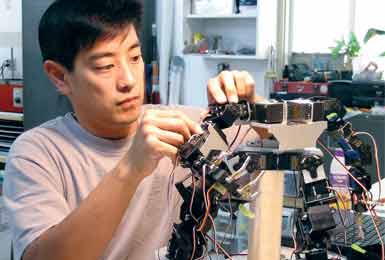New Vocationalism: The Way to a Winning Work Force?
April 2012

Labor Market Deficits
The U.S. Bureau of Labor Statistics reported in March that manufacturing employment rose by 31,000 in February, but the sector was held back by a shortage of skilled labor. A recent survey of American manufacturers by Deloitte Consulting LLP found 5 percent of manufacturing jobs - 600,000 nationwide - were going unfilled because industrial firms couldn't find workers with the right skills, even with national unemployment rate above 9 percent.
Business/education partnerships grow out of market deficits like those noted in the Deloitte study. In Newport News, Virginia, for example, Northrop Grumman needed a steady supply of skilled welders, maintenance technicians, and engineers. The company partners its Apprentice School of Shipbuilding with area community colleges such as Tidewater and Thomas Nelson. Northrop has developed articulation agreements with area colleges so credits earned in the apprentice school count toward Associate's and Bachelor's degrees in the colleges. In turn, the company provides qualified college students full tuition to take computer-aided design and mechanical engineering courses, and then employs them upon graduation at middle-income starting salaries.
Increase in College/Business Collaborations
While colleges may view too tight a bond with business as subverting their mission of providing well-rounded education, they are also facing significant declines in state and federal funding. Illinois State University's report on higher education funding shows a 7.6 percent decline nationally in state support from 2011 to 2012, with 29 states appropriating less than they did five years ago. Declining government support may translate into more college/business collaborations, where schools accept more corporate support in return for delivering ready-to-go workers. The academic budget crunch provides an opportunity for companies willing to partner with area schools.
One of those is RobotWorx, an Ohio robot integrator and re-manufacturer. Owner Keith Wanner estimates that within 200 miles of his Marion, Ohio, plant lies 85 percent of the U.S. industrial robot market. He notes, however, a dearth of training for robot techs and engineers. Honda's Ohio plants are 30 minutes away. Many more automotive assembly and supplier plants are scattered throughout Ohio, Indiana, Kentucky, and Michigan. "They're crying for qualified robot technicians," says Wanner.
Recognizing the need, in true "new vocational" fashion, Wanner has started conversations with three local schools. The regional campus of Ohio State University, Marion Technical College, and Tri-Rivers Career Center are now developing an industrial robotics and automation training center. With equipment donated by RobotWorx, Fanuc, and others, the center will be operational by this fall, utilized by each school in its technical and engineering courses. Students will have co-op opportunities with member companies and a pathway up the educational ladder toward a four-year engineering degree - or they can jump off with a certificate or Associate's degree and go to work.
Project Announcements
Australia-Based Aquatic Leisure Technologies Group Plans Opp, Alabama, Manufacturing Operations
12/11/2025
Teradyne Plans Wixom, Michigan, Robotics Operations
12/11/2025
Robinson Plans Altoona, Iowa, Manufacturing Operations
12/11/2025
BioTouch Expands Columbus, Georgia, Operations
12/11/2025
Natrion Plans Erie County, New York, Battery Components Operations
12/11/2025
Czech-Based GZ PrintPak Expands Mount Pleasant, Wisconsin, Manufacturing Operations
12/11/2025
Most Read
-
The Workforce Bottleneck in America’s Manufacturing Revival
Q4 2025
-
Rethinking Local Governments Through Consolidation and Choice
Q3 2025
-
First Person: Filter King’s Expansion Playbook
Q3 2025
-
Lead with Facts, Land the Deal
Q3 2025
-
How Canada Stays Competitive
Q3 2025
-
Investors Seek Shelter in Food-Focused Real Estate
Q3 2025
-
America’s Aerospace Reboot
Q3 2025


